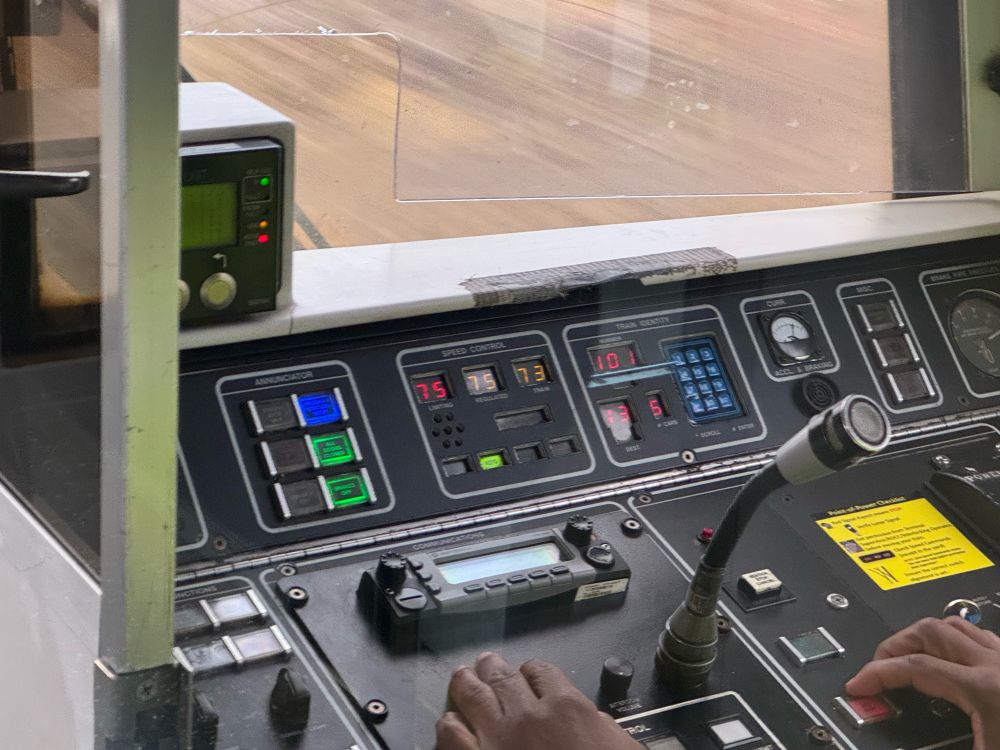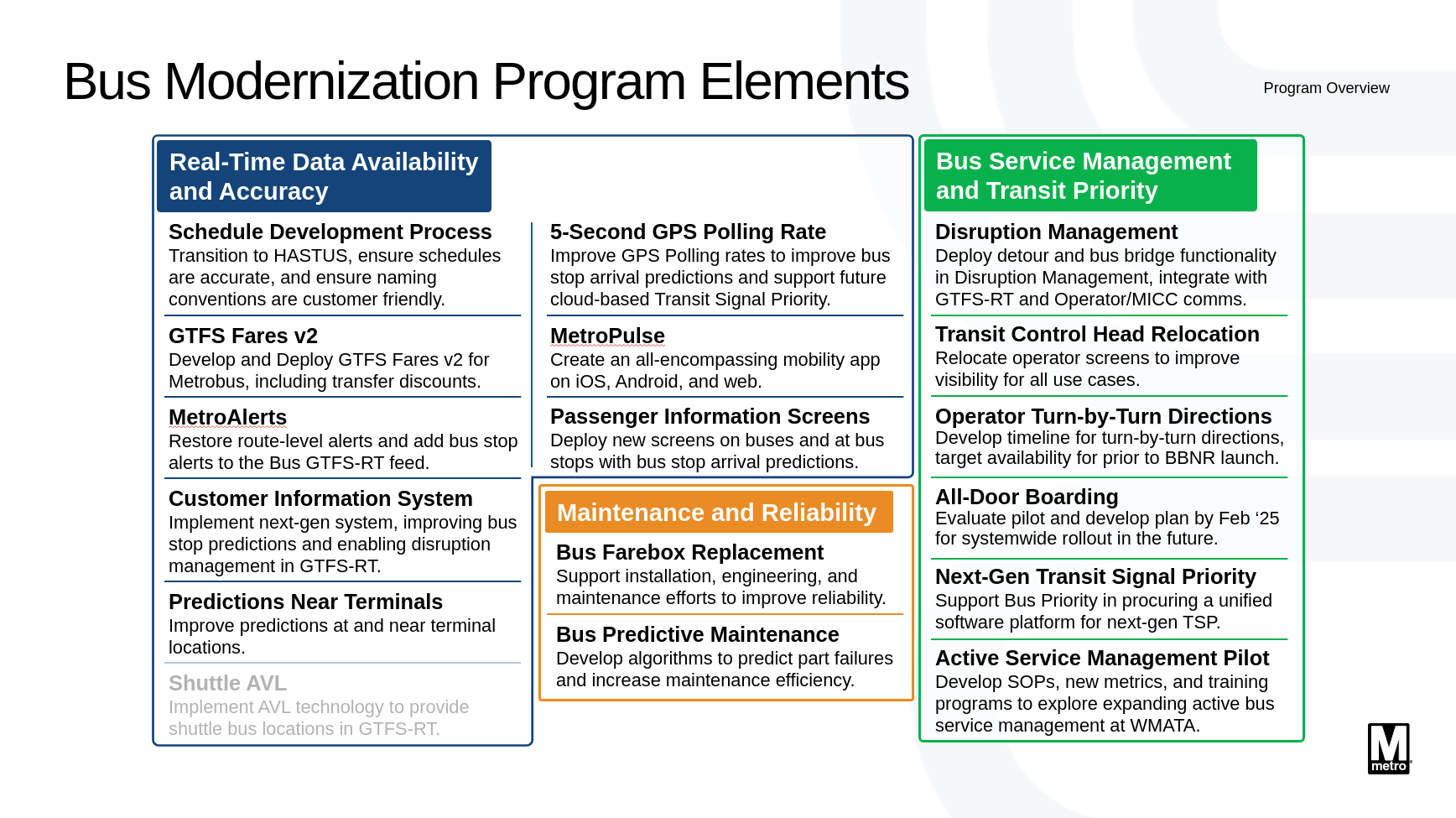Reflecting on Two and a Half Years at WMATA

To protect folks’ privacy, I’ve avoided using names throughout the post.
At the top of every production data pipeline I've written, I print out a Lord of the Rings quote as an Easter Egg for any future developers/analysts who pick up the code. Keeping this tradition alive, here's a bit of a sappy quote reflecting on my time at WMATA:
It's a dangerous business, Frodo, going out your door. You step onto the road, and if you don't keep your feet, there's no knowing where you might be swept off to.
After nearly 6 years at New York City Transit, I joined the Washington Metropolitan Area Transit Authority (WMATA, or Metro for DC locals) in July 2022. I was still riding the high of my experience at New York City Transit, and it was just a few weeks before Randy Clarke joined Metro as well.
To give a sense of the media environment around Metro at the time, the agency was coming off a decade of negative headlines and long overdue repair work which negatively impacted service. The negative trend culminated in Metro pulling 60% of its railcars out of service after a derailment in October 2021. The agency was simultaneously facing a shortage of bus and train operators post-COVID as well as a slower ridership recovery than many of its peers (reflecting D.C.'s relatively slow reopening and return to the office). It was a little intimidating to say the least.
Despite the negative news stories, I was welcomed by an incredibly dedicated and smart group of public servants who truly believed in the mission of public transit and were willing to work long hours diving into the weeds of policy papers, budgets, and intricate transit data. While it admittedly took me a minute to find my footing in the agency, it's difficult to describe how much fun it's been to be a part of my hometown agency’s comeback story. I feel such an immense amount of pride every time I see a bus or train full of people going about their lives.
Digging Into Transit Data
My first role at Metro was working as a "Business Intelligence Manager" on the Capital Systems Intelligence team (yes, the acronym was CSI), now known as Data Lab. My first boss brought me in to help build up Metro's backend data infrastructure to support analysis on transit operations data and farecard/ridership data. While I'd spent nearly 6 years in my previous role working on transit data, Metro's setup was pretty different, relying on combining separate Oracle databases together with Oracle database links, all of which had pretty different performance characteristics.
While the main day-to-day responsibilities of the role was acting as a Database Administrator to support other analysts in the Office of Planning, I also oversaw two task orders focused on processing bus movement data. The more interesting of the two was called Rawnav.
I could write a whole post on its own about what you can do with fine-grained GPS data, but the short version is that while customers only see GPS updates for Metrobus in apps like Google Maps every ~30 seconds, the bus is recording its GPS location 1-2 times per second while moving. Using this data, you can do very cool things like break apart the different types of delay that can impact service (e.g. differentiating between delay from a poorly configured traffic signal and delay from high levels of congestion). This type of analysis seems like it would be easy enough to do visually by sending out someone to watch the street, but it’s too expensive to do that systemwide or over long periods.

Overall, the role was an interesting introduction to a lot of different people and groups at Metro, and learning how all the data systems worked was very helpful for future projects. That said, I was ready for something with a bit more of a direct impact on service.
Strategy, Policy, and Customer Journey Time Opportunities
After about 9 months at Metro, an opportunity came up to work on the Strategy and Policy team. After joining the team, my first assignment was to put together a short brief on opportunities to improve customer journey times on Metrorail. I’d managed the SPEED team for a while at NYCT, so I think my new boss thought this was a natural fit for me after he got the request. The Customer Journey Time Opportunities Brief turned into an incredibly fun project to work on, and it gave me an opportunity to contribute to the push to return to Automatic Train Operation and increasing the top speed back to 75 mph.
For the brief, we started with a wide scan identifying all the places customers spend time throughout the Metrorail system:
- Time getting to the station
- Time entering/exiting the station
- Time waiting for trains
- Time on the train
Time getting to the station was largely out of scope so we quickly moved our focus to time entering/exiting the station. Initially this avenue looked promising given how much slower our escalators are than those in other countries. It turns out though that the relevant ASME code in the U.S. cap out escalator speeds at 100 feet/minute, and Metro already had plans to upgrade the remaining 50% of escalators that ran at 90 ft/minute to 100. For reference, NYCT self-insures and ignores the code at some stations to go up to 120 ft/min, but other agencies in countries like Singapore will go as high as 160 ft/min.
Time waiting for trains is pretty straightforward to solve and more or less just requires increasing service assuming that service doesn’t get bunched. There’s many people at Metro (and most transit agencies) who spend time balancing customer demand and wait times with finite funding. There’s also a team of customer experience staff who think about ways to make waiting in a station less frustrating. With so much attention to service levels and customer experience already, it wasn’t a great opportunity for our team to contribute.
Time spent on the train was a different story though. There were three big opportunities to speed up in-vehicle travel times, which you might have seen in the news over the last year if you follow transit or live in the D.C. area:
- Restore Automatic Train Operation (ATO), not in use since 2009
- Restore Automatic Door Operation (ADO), not in use since 2008
- Return to Design Speeds (increase max speed limit back to 75 mph from 59 mph), not allowed since 1986.
ATO and ADO already had a pretty large movement behind them internally thanks to the leadership of the Communications and Signaling team and many other incredible folks, but increasing the speed limit back to 75 mph had less momentum. As I understand it, a director in the Communications and Signaling Department had put together a detailed engineering document outlining what would need to happen to restore the old speed limits, but he hadn’t had too many people bite when pitching it. To my not-quite-engineer eye, the work looked great.
Working with an analyst, we called up all the different stakeholders (safety, rail car maintenance, track maintenance, power, etc.) to make sure they didn’t foresee any big red flags before pitching it to execs, since we knew they’d have to do a lot of engineering and validation work if anyone saw the scale of the opportunity.
I’m not sure whether Randy Clarke initially pitched it, or if it was the woman who ultimately organized and ran the meetings, or even somebody else, but shortly after Randy started, Metro started having a recurring internal Service Excellence meeting where staff could highlight great work to improve service or propose future improvements. My boss got us on the agenda for August 2023, the second ever Service Excellence meeting.
Working with analysts on my team and engineers in Communication and Signaling, we put together estimates for runtime savings and the potential return on investment for each component of the whole “Rail Automation” program, along with a slide deck to help sell it. Putting together the presentation was super fun since I got to watch my engineering colleagues shine during the presentation (I only presented a couple slides since they had done the technical work). From my perspective, this presentation was an important turning point to get relatively new executives on board.
While I put together the initial version for that slide deck back in August 2023, the chart (with updated numbers from real testing) has been circulating lately in the news, and I remain pretty proud of it. For reference, on the SPEED team at NYCT we were usually fighting for 2 or 3 seconds at a time, so I was so incredibly excited when I saw these numbers in our analyses showing up to 10% (!!) running time savings:

Now that the engineers had approval to really dive in under the project management of the rail automation project manager, my role on the project was mostly done.
It was so cool getting to go out on December 15th, 2024 and ride the red line train with Automatic Train Operation, with Automatic Door Operation, and at 73 mph (ATO usually goes a couple mph below the speed limit), all knowing I’d played a small part:

WMATA’s Fiscal Cliff
Towards the second half of May 2023, and after I finished my initial brief on Opportunities to Improve Customer Journey Times, we got the request from the top that it was time to start introducing Fiscal Cliff messaging for the upcoming FY2025 budget gap.
There’s a few different reasons that the FY2025 budget was in such rough shape:
- Plummeting transit ridership during the early part of the pandemic
- Changes in ridership patterns meaning average fares had gone down in Metrorail’s time of day and distance based fare system.
- High levels of inflation with automatic cost of living raises based built into Collective Bargaining Agreements
- A quirky jurisdiction subsidy credit where Metro provided support to local jurisdictions in the form of a subsidy reduction since the federal government bailed out transit agencies before local governments.
Getting the initial messaging right was one of the top priorities for the agency, and following a recommendation from a former New York City Transit colleague who also made the move to D.C. to whom I’m incredibly grateful, I wound up on the team of about 6 responsible for putting together the initial presentation (in total though, I think I knew of over 50 people who contributed in some way to the effort).
I can’t talk too much about the development of the messaging plan for obvious reasons, but oh my gosh it was so much work. The work was also pretty different from what I’d done in the past, focusing so much on the doomsday of a D.C. without useful transit with the goal of keeping the bad thing from happening (as opposed to working on projects that will improve service).
We partnered with a whole host of teams internally to put together over 20 different briefs and mini-decks with background on Metro’s history, human-readable explanations of how Metro’s funding/revenue and budget work, scenarios for what the region would look like without service, etc. It was 60-80 hours a week of just my time (much less anyone else’s) for a month and a half, culminating in a presentation that got more or less exactly the response and media coverage we were hoping for.

It was so fun seeing the slides and work that I’d done show up on news feeds and newspapers around the region.
After publication, I promptly went on a long-planned two week vacation to Europe to see family and by the time I was back the team was in service planning mode and my role had mostly subsided, except as a pinch hitter if someone was out sick or on vacation when a request came up.
Creating The Bus Modernization Program
Following the successes of the Customer Journey Time and Fiscal Cliff projects, I started looking around for my next project.
The team I was on encouraged staff to pitch their own ideas for projects between top-down requests, and I’ve always loved working on bus projects since the timelines to see change are often much quicker than on rail. Before joining the Office of Strategy and Policy, I’d actually considered trying to join WMATA’s Bus Priority team, and I helped them out on a few analyses and presentations while waiting for a new project to work on.
High Frequency Bus GPS Polling and Cloud-TSP
During another Service Excellence meeting in October 2023 (this time focusing on bus service), Randy Clarke mentioned he wanted much higher-frequency GPS updates in navigation apps. This request might seem pretty in the weeds for a transit agency head, but he’s a fairly regular bus rider. As a regular rider, he’s dealt with an all-too familiar experience of just missing the bus that you thought was still 30 seconds away, just to face a 20 minute wait for the next one.
Around the same time as the presentation, a project manager who was on the bus priority team had told me about an awesome new technology that we dubbed ‘Cloud-TSP’ as a shorthand, which needed high-frequency GPS to work.
Transit Signal Priority (TSP) is a fairly old technology. At a high level, it’s actually a set of technologies that adjust signal timing dynamically to try and ensure buses/trains spend less time waiting at a red light. Old school approaches usually use radio waves to communicate between the bus and a controller at a given intersection. When a bus gets close to the intersection, the signal controller either keeps the green light going longer so the bus can get through, or it shortens the red light.
The old school approach can work really well if tuned correctly, but it still requires hardware on the bus and at the intersection. The sudden light changes can mess up traffic on the crossing road as well (which might also have buses on it!). What we called “Cloud-TSP” just uses bus GPS positions to tell if a bus is getting close to an intersection. When it does, a central monitoring server sends the priority request to the signal controller at the intersection. The Cloud-TSP version requires no extra hardware on the bus or at the signal, but it does require networked traffic signals and frequent bus GPS updates.
A few companies offer this technology now, but a company called LYT pioneered an approach that uses machine learning to estimate when a bus will arrive at an intersection 5+ minutes in advance and starts to make small changes to the signal timing to make sure the bus will have a green light when it arrives. This works best with bus lanes so travel times are consistent, and TriMet in Portland saw runtime savings of 15-18% on their bus route with dedicated lanes in an on/off test (for reference if you’re not in transit, this is a jaw-dropping number).

I talked to the Bus Technology team and other folks in Digital Modernization at WMATA. With the help of bus technology staff, I figured out how to put a business case together for frequent GPS polling. The return on investment was good enough it wound up being pretty easy to get funding.
While working on this whole proposal and business case, it seemed like there was a bit of a gap where there were great project managers and teams to manage individual projects, but nobody to pull it all together to make sure the teams talked to each other or to make the case for new projects. I was taking over the “Bus Customer Information Improvement” program from a colleague who was switching teams, so with my boss’ permission, I renamed the program “Bus Modernization” and set up the first Bus Modernization Program Update meeting. I invited all the relevant executives and directors/senior managers and let the relevant project managers give updates on their progress and upcoming plans.
In the end, I ran the program for about a year, coordinating between about 14 different projects and leading around 4 myself, all of which I can share thanks to a presentation at CleverConnect last October:

Closing a Bus Garage, Assorted Projects, and Closing Thoughts
While all the above projects had public documents I could point to making writing about them easier, there were a handful of other side projects I wound up helping with too.
I worked with the capital planning team to put together the sales pitch for closing Southern Avenue Bus Division and then helped coordinate the garage closure. I got to work with an analyst to poke my head into Supply Chain Modernization to start making the case for improvements. I got to listen and provide feedback on projects that are part of WMATA’s Academic Research Project partnership with MIT. I reviewed physical and digital wayfinding comps…
On my last day I handed in my laptop and badge and took one last look at the METRO sign in the lobby. Walking out to the L’Enfant Plaza station, I tapped in with my own phone and hopped on the train back to my apartment to clean it up to get ready to move. It’s a bit sappy in the way one can get on your last day at a job you love, but I am so grateful to all my amazing colleagues, particularly my supervisors, who let me work on so many cool projects.

